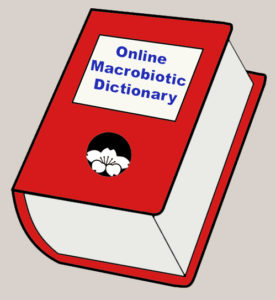
Completed Entries
Type of winter squash that has the highest sugar content that originated in the United States. It is also known as Hokkaido squash or pumpkin.
Edible dried gourd strips, often used for tying foods.
Seaweed gelatin, also called agar-agar or Ceylon moss.
Deep-fried rolled-out dough shapes.
Cooked buckwheat groats, Russian-style.
Soft-cooked rice or other grain cooked a long time in a lot of water until it is soft and creamy.
Sautéed vegetable stew with oil.
Ki energy is an unseen life force or universal energy that exists everywhere uniting all the manifestations of the universe, visible or invisible. It is referred to as “Ki” in Japan, as “Chi” or “Qi” in China, and as “Prana” in Sanskrit. Stagnation (the stopping or slowing down of ki energy) is the first step/cause of disease.
Dried Japanese mushroom, called ‘ear mushroom.’ A thinner variety than shiitake, it grows on trees.
Burdock and carrot dish—cut sengiri, sautéed, and seasoned with soy sauce.
Roasted and chopped sesame seeds.
Vegetables cut in thin rounds.
Traditional Japanese stew made with carp and burdock.
Enzyme used in fermentation of traditional Japanese foods. Packaging often includes directions for making homemade amasake and/or other fermented products.
Grain cereal or ‘grain milk’ for babies made from brown rice, sweet brown rice, sesame seeds, minimal sea salt, and water.
Japanese seaweed of the brown algae family grown in long streamers that lie along the sea bottom in deep intertidal waters. Kombu contains high amounts of potassium iodine, and calcium and is often used in soups, bean dishes, and condiments.
A translucent gelatinous cake made from yam starch.
Kukicha is a Japanese tea made from 100 percent twigs or stems of the tea plant (camellia sinensis). The twigs and stems are aged three years and then roasted, making it one of the least yin drinks among plant-based beverages and containing about one-fifth as much caffeine as green tea. Bancha tea contains about 60 percent twigs and stems and 40 percent leaves of the tea plant. Kukicha contains vitamins C, B1, B2, A, niacin, theanine, catechin (polyphenols), flavonoids, amino acids, selenium, copper, zinc, fluorine, manganese, and six times more calcium than cow’s milk. There are many reported health benefits of drinking kukicha—from helping prevent cancer and supporting cardiovascular health to aiding in the digestion of grains and vegetables and boosting energy levels. Kukicha (or bancha) serves as a base for many remedial drinks and is one of several primary-use beverages in a macrobiotic practice. Other primary beverages include spring, well, or filtered water and teas made from roasted whole grains such as barley or brown rice.
High quality starch, similar to arrowroot, extracted from the root of a Japanese wild plant, used medicinally and also in cooking as a thickener. It is often used in cases of sharp intestinal pains, diarrhea, dysentery, cholera, and intestinal tuberculosis because of its strong contracting quality.
Projected Entries
Kaibara, Ekiken
Karma
Kelp
Kennedy, Bob
Kervran, Prof. Louis C.
Key to freedom
Kidney disease
Kidney stones
Kidneys
Kikuchi, Tomio
Kim-chi
Kinako
Kohler, Jean and Mary Alice
Kojiki
Konnyaku plaster
Kusa
Kushi, Aveline
Kushi Institute
Kushi, Michio
Kuzu drink
Kuzu-ume-sho drink
Questions or Comments?




